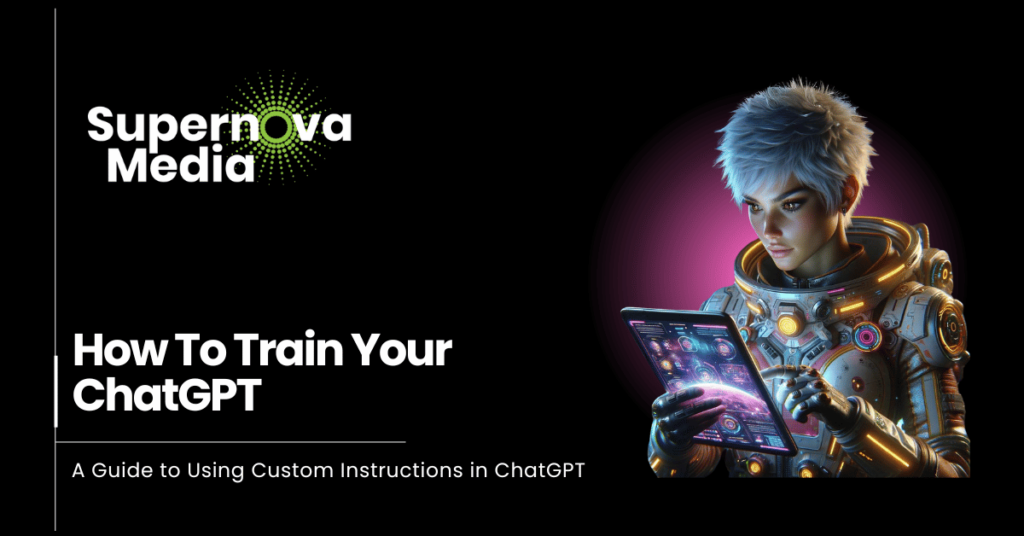
Custom Instructions: Personalizing ChatGPT for Your Needs
Welcome back to Jupiter Journals! Today, we’re exploring (one of my favorite and) time-saving features that can streamline your interactions with Custom Instructions for ChatGPT.
Custom instructions are settings that guide ChatGPT’s behaviour. Think of them as your personal “style guide” for the AI.
Once set, these instructions will influence all your future interactions with ChatGPT, making it easier to get the responses you’re looking for.
Whether you’re a teacher, marketer, developer, or just someone looking to make your AI communications more personalized, this guide is for you.
Why Custom Instructions Matter
Custom instructions improve the AI’s contextual understanding, helping it grasp the nuances of the user’s inquiries or tasks, leading to more accurate and helpful responses.
Benefits of Custom Instructions
- Occupational Relevance: Tailor responses to your line of work.
- Tone and Style: Choose how formal or casual you want the AI’s responses to be.
- Response Length: Decide how detailed or concise you want the answers.
Setting Up Custom Instructions
Great news! With 4o model update Custom Instructions are now available to free users!
Steps to Enable Custom Instructions:
- Access Custom Instructions: Click on your name in the ChatGPT interface to open the settings menu.
- Select Custom Instructions: Find and click on the “Custom Instructions” option.
- Enter Your Preferences: You’ll see two text boxes where you can answer the following questions:
- What should ChatGPT know about you to provide better responses?
- How would you like ChatGPT to respond?
- Save: Click save to apply your custom instructions. Remember to keep within the 1,500-character limit.
By following these steps, you can tailor ChatGPT to better fit your unique needs and preferences.
Disclaimer: Like any AI – it doesn’t always work. You may need to prompt the AI to remind it. Also – they do not work in Custom GPTs.
Practical Applications of Custom Instructions
Custom instructions are very versatile. Here are just a few ways you can use them:
- Teaching: A teacher can specify that they are teaching 3rd grade science, so they don’t have to repeat this information in every query.
- Content Creation: A blogger can define a preferred tone and style, ensuring consistency across all generated content.
- Business: A marketer can specify the target audience and desired outcomes for more effective ad copy.
Example Custom Instruction Setup
Tip: Make full use of the 1,500-character limit, here’s a custom instruction setup for a tech blogger:
What should ChatGPT know about you to provide better responses?
“I am a tech blogger focused on AI and machine learning. My audience includes tech enthusiasts, AI professionals, and novices interested in practical applications of AI. I write detailed, insightful articles with a professional yet approachable tone. I often include real-world examples, case studies, and data-driven insights to support my points. My content aims to educate, inspire, and provide actionable advice. Please ensure responses are informative, engaging, and tailored to both technical and non-technical readers.”
How would you like ChatGPT to respond?
“Please respond in a tone that is professional but accessible. Use clear, concise language and avoid jargon where possible, or explain it if necessary. Structure responses logically, with headings and bullet points for clarity. Provide detailed explanations and include examples or analogies to help illustrate complex concepts. Maintain an encouraging and positive tone, emphasizing practical benefits and applications of AI. When appropriate, suggest further reading or additional resources.”
Tips & Tricks for Custom Instructions
- Be Specific: The more specific you are, the better the AI can assist you.
- Assign a Role: Set roles like “Programmer,” “Writer,” or “Analyst” to get specialized assistance.
- Test and Tweak: Don’t hesitate to refine your instructions for better results.
Use Cases for Custom Instructions
Custom instructions can significantly enhance various aspects of AI interactions, such as:
- Expertise Calibration: Ensure responses match your level of expertise.
- Writing Style Personalization: Maintain a consistent writing style across all outputs.
- Localization: Adapt responses to fit regional preferences.
- Tone Setting: Establish a consistent tone for all communications.
- Policy Adherence: Ensure all responses align with specific policies.
- Consistent Character Voice: Perfect for creative writing and role-playing scenarios.
Conclusion
ChatGPT’s custom instructions are like a finely-tuned autopilot, mirroring your unique style in every response. By taking the time to set up and refine these instructions, you can make your interactions with AI more productive and personalized.
Download this Guide: Custom Instructions For ChatGPT
For more detailed tutorials and tips on Training ChatGPT to Write Like You, visit our full guide on Supernova Media.
Want More? Join Tech Tactics. And Subscribe to biweekly updates.














